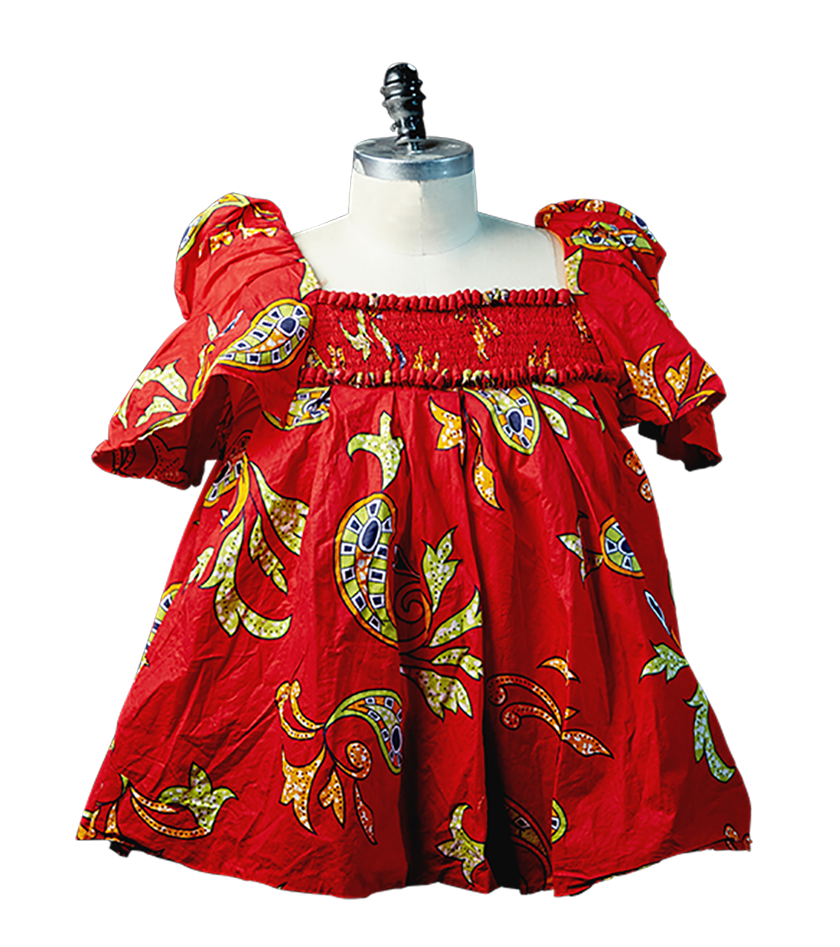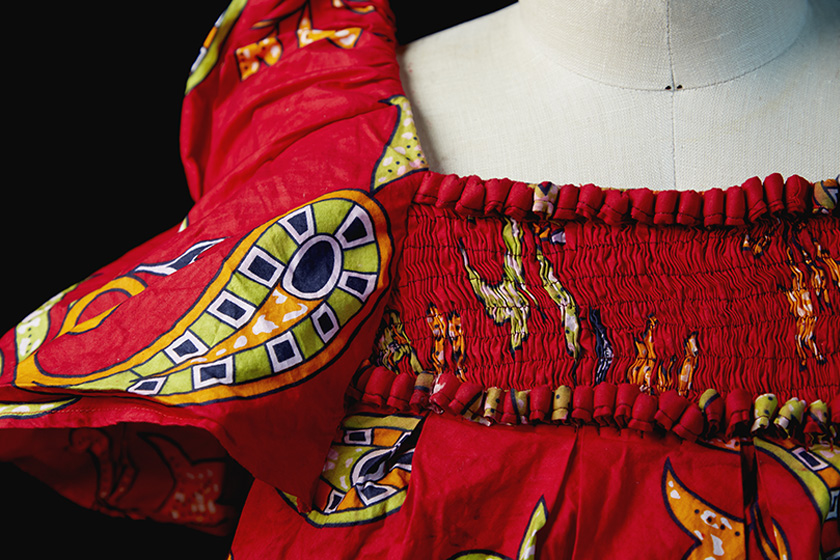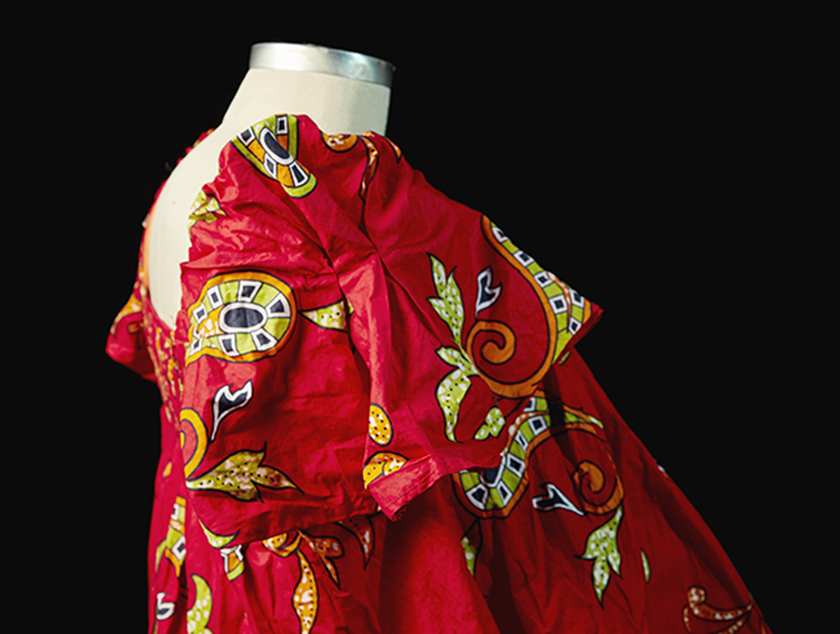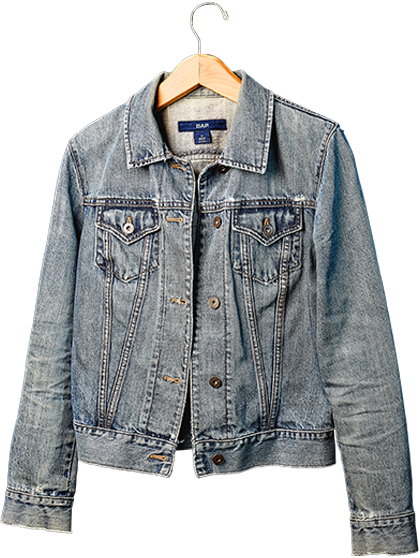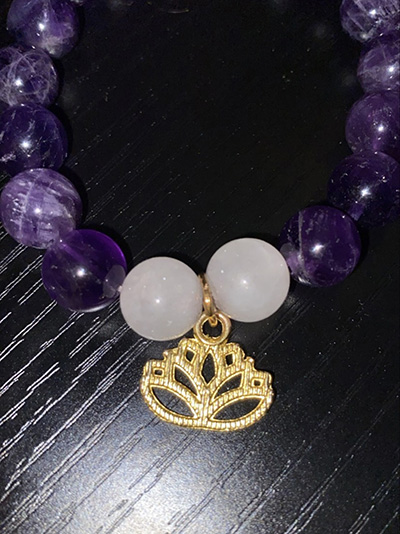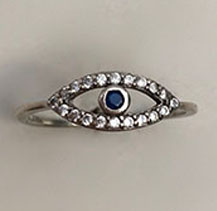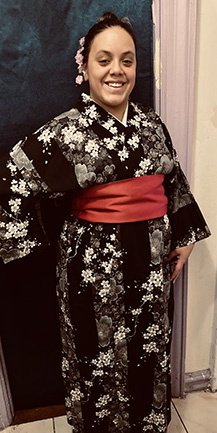Kente / Ankara / Kitenge Cloth
ABOUT
Powerful objects are those that hold priority in a person’s life. This clothing item has a red background and a yellow, blue, white, and orange petal or bird-like print on it. Initially, this cloth was perceived to be Kente cloth, a Danshiki, or Angelina print. Through my research, I determined that this fabric is actually referred to as an Ankara cloth by West Africans or Kitenge by East Africans. This cloth uses the batik method–a type of wax-resist dyeing–developed by Indonesian artisans. It is said that when Africans were recruited into the Indonesian army, they adapted the batik method to create different colorful designs before sewing them into various garments. The Ankara/Kitenge cloth is of great value to African societies as well as Black American communities. These types of patterns and fabrics have been integrated into Black American culture even though wearers may be unaware of the patterns’ specific African roots. Black Americans sometimes wear different types of African clothing like Kente cloth, Bògòlanfini (handmade dyed fabric from Mali with sticks, stones, roots, and bones patterns), Adire (tie-dyed cloth made by Yoruba women in Nigeria), Kanga (brightly colored printed cloth of East Africa), and Adinkra (from the Asante people in Ghana) and others as a sense of belonging to various African cultures. This cloth’s owner, Angelise Freeman, explains how, in spite of its simple appearance, this Ankara/Kitenge cloth has an intricate history. Angelise observes that the cloth has become an object of power and value to her as she feels a sense of identity to the culture and its people.
The original item for this exhibition was a Kente skirt but, because of COVID-19 related disruptions, Angelise Freeman handed in this Ankara/Kitenge blouse instead; she decided it has the same impact on the Black American Society as the Kente cloth.
— Josephine Elumeze
PIDGIN TRANSLATION BY JOSEPHINE ELUMEZE
Thing wey dey dear to pesin na wetin dem they call object wey dey carry ogbonge weight for pesin heart cause of wetin e mean for that pesin. E be like say as time dey pass for our place, Africa, we no sabi when dem start to dey make cloth cause dem no dey write am. This cloth wey I dey talk so, e get red background with yellow plus blue, white and orange wey be like petal or feather on am. I no sure say na better kente be this, na so I been dey look am. E no look like say na hin. I com dey look sey wetin be this.
Before before I dey think say this cloth na kente, Danshiki, Angelina print but now I don reason am say na East and West Africa get am. For West Africa, dem they call am Ankara but for East dem dey call am Kitenge. E get plenty name for Africa. Batik, wey get hin origin for inside Indonesia na hin be the method wey dem dey use take do this cloth. Dem fit use wax, dye and cloth do am. For Africa, dem they use plenty colors and plenty fine and bright designs make am. Dem dey use am do diferent diferent things.
No be for only Africa this Ankara or Kitenge dey carry weight for pesin heart, our obodo oyinbo pesins too dey like am well well. Ankara or Kitenge anyway wey you wan call am na cloth wey black oyinbo pesins wey get am dey hold dear to hin heart cause dem no no where dem (black oyinbo) dey come from for Africa. Because dem no no where dem (black oyinbo) dey come from, dem com say make dem wear plenty African cloth like Kente cloth, Bogolanfini (pako, stones, roots, and bones), Adire, Kanga, Adinkra dem so make dem feel like say them be like dem African pesins.
TRANSLATION BY JOSEPHINE ELUMEZE, READ IN PIDGIN BY AISHA MUNIRA NASIRU
YEMI ALADE AND SAUTI SOL, “AFRICA”
Click on Image to View Gallery
ORIGIN
East and West Africa
APPROXIMATE DATE
Unknown (originating after 1800)
MATERIALS
Wax resist cotton
COLLECTION OF
Angelise Freeman

Kente / Ankara / Kitenge Cloth
Click on Image to View Gallery
ABOUT
Powerful objects are those that hold priority in a person’s life. This clothing item has a red background and a yellow, blue, white, and orange petal or bird-like print on it. Initially, this cloth was perceived to be Kente cloth, a Danshiki, or Angelina print. Through my research, I determined that this fabric is actually referred to as an Ankara cloth by West Africans or Kitenge by East Africans. This cloth uses the batik method–a type of wax-resist dyeing–developed by Indonesian artisans. It is said that when Africans were recruited into the Indonesian army, they adapted the batik method to create different colorful designs before sewing them into various garments. The Ankara/Kitenge cloth is of great value to African societies as well as Black American communities. These types of patterns and fabrics have been integrated into Black American culture even though wearers may be unaware of the patterns’ specific African roots. Black Americans sometimes wear different types of African clothing like Kente cloth, Bògòlanfini (handmade dyed fabric from Mali with sticks, stones, roots, and bones patterns), Adire (tie-dyed cloth made by Yoruba women in Nigeria), Kanga (brightly colored printed cloth of East Africa), and Adinkra (from the Asante people in Ghana) and others as a sense of belonging to various African cultures. This cloth’s owner, Angelise Freeman, explains how, in spite of its simple appearance, this Ankara/Kitenge cloth has an intricate history. Angelise observes that the cloth has become an object of power and value to her as she feels a sense of identity to the culture and its people.
The original item for this exhibition was a Kente skirt but, because of COVID-19 related disruptions, Angelise Freeman handed in this Ankara/Kitenge blouse instead; she decided it has the same impact on the Black American Society as the Kente cloth.
— Josephine Elumeze
PIDGIN TRANSLATION BY JOSEPHINE ELUMEZE
Thing wey dey dear to pesin na wetin dem they call object wey dey carry ogbonge weight for pesin heart cause of wetin e mean for that pesin. E be like say as time dey pass for our place, Africa, we no sabi when dem start to dey make cloth cause dem no dey write am. This cloth wey I dey talk so, e get red background with yellow plus blue, white and orange wey be like petal or feather on am. I no sure say na better kente be this, na so I been dey look am. E no look like say na hin. I com dey look sey wetin be this.
Before before I dey think say this cloth na kente, Danshiki, Angelina print but now I don reason am say na East and West Africa get am. For West Africa, dem they call am Ankara but for East dem dey call am Kitenge. E get plenty name for Africa. Batik, wey get hin origin for inside Indonesia na hin be the method wey dem dey use take do this cloth. Dem fit use wax, dye and cloth do am. For Africa, dem they use plenty colors and plenty fine and bright designs make am. Dem dey use am do diferent diferent things.
No be for only Africa this Ankara or Kitenge dey carry weight for pesin heart, our obodo oyinbo pesins too dey like am well well. Ankara or Kitenge anyway wey you wan call am na cloth wey black oyinbo pesins wey get am dey hold dear to hin heart cause dem no no where dem (black oyinbo) dey come from for Africa. Because dem no no where dem (black oyinbo) dey come from, dem com say make dem wear plenty African cloth like Kente cloth, Bogolanfini (pako, stones, roots, and bones), Adire, Kanga, Adinkra dem so make dem feel like say them be like dem African pesins.
ORIGIN
East and West Africa
APPROXIMATE DATE
Unknown (originating after 1800)
MATERIALS
Wax resist cotton
COLLECTION OF
Angelise Freeman

TRANSLATION BY JOSEPHINE ELUMEZE, READ IN PIDGIN BY AISHA MUNIRA NASIRU
YEMI ALADE AND SAUTI SOL, “AFRICA”
OTHER OBJECTS FROM THE EXHIBITION

